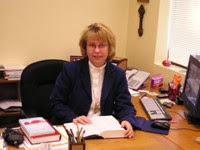This Easter season, we continue to read from the Gospel of John, despite the fact that we are in the year of Matthew. Each Sunday we read the poetic pre-cross/resurrection accounts of Jesus life. John seemed to see ‘telling’ accounts of Jesus’ glory and intent in everything he said and did.
The community for which the Gospel of John was written was a very special group of believers. They were among the first to actually understand theologically that Jesus was God. They worked out the presence of God in man or what we would later call ‘incarnation’. Because of their free thoughts of Christ, they were expelled from the synagogues and may have been a bit bitter about their treatment. The gospel is harsh on Jews and in fact can be read as anti-Jewish IF you are not careful. Most probably, the Johannine Community was arguing with their relatives! It was a family squabble.
I believe that the best way to read the gospel is to read yourself into it.
Throughout the book there are references made to the ‘beloved disciple’. The disciple is never named. This disciple could have been any one of the members of the Johannine community – or it could be you! And in just the same manner, we are the ones that shut out the radical, liberal gospel message of a God and man that walks among us. As the season of Easter comes to a close and we move into the ongoing mission and ministry presented to us in the Pentecost, may you be beloved and may you seek to open the doors of your faith to new and ‘resurrecting’ ideas.
Pastor Lynnae
♥ ♥ ♥
When I was in seminary I read a book called “Re-pitching the Tent”. It was all about the building of church ‘buildings’. Faith community worship began on a mountain with a stone altar and has developed into the church structures of today. Some of the most beautiful churches that I have ever seen (other than the FULL ones) are churches that are built in a simple style and that have a story to tell.
Some of the most unusual, are “the wooden churches – the majority of which were built in accordance with laws that discriminated against non-Catholics. No other European country has as high a density and great a diversity of wooden churches as Slovakia, so of course, I am partial to them!
Slovakia has the highest density of wooden churches anywhere in Europe. In 1681, the Roman Catholic Austro-Hungarian Emperor dictated that only Roman Catholic churches could use hard materials (stone, metal). Protestant and Ruthenian/Rusyn Greek Catholic churches could only be made of wood and were not allowed to use nails in their construction. They had to be
erected within one year, start to finish, and were not permitted in the center of town.
Builders used ingenious carpentry techniques for joining together pieces of wood to create these lovely churches. Weathered, dark wooden shingles seem to ripple and flow, like snakeskin, over these organic-looking structures.” (from the CometoSlovakia.com web page)
Within the inner sanctuaries of these churches I first encountered ‘painted churches’. I found on the ceilings beautiful scenes of clouds and blue skies, depicted it seemed to be like looking into the heavens. One church had each of their organs wind pipes painted to look like a singing choir of openmouthed angels. Unknown artists worked painfully to grace the simple woodwork with images of the holy.
Upon returning to Texas, I was astonished to find the painted churches of our own areas had Czechoslovak and German immigrant heritage. In the Mid-19th century the immigrants
banded together in small communities on the rolling plains of Texas and churches were among the first structures that they built. Join us on April 17th as we take a tour of the painted churches of Texas and learn a little about our heritage. Call the church office to reserve your
place in the van!
Pastor Lynnae
